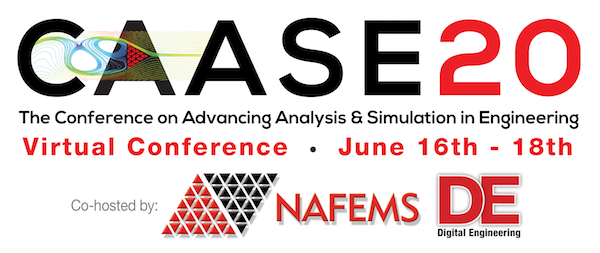
Latest News
February 5, 2020
Innovative disruption is a fact of life for design engineers, given the push to more rapidly produce and iterate new designs. Simulation and design software vendors are also facing multiple disruptions with the advent of cloud-based software and flexible licensing models, as well as a push for a greater democratization of simulation systems.
That’s why author and speaker Geoffrey Moore (www.geoffreyamoore.com) is such a good choice to present one of the keynote sessions at the upcoming CAASE20 (the Conference on Advancing Analysis & Simulation in Engineering) virtual event, June 16-18, 2020. The conference is presented by NAFEMS Americas and Digital Engineering.
CAASE20 brings together the leading visionaries, developers, and practitioners of CAE-related technologies in an open forum to share experiences, discuss relevant trends, discover common themes, and explore future issues. The conference will cover a wide range of topics, including every aspect of engineering analysis and simulation.
Moore is the author of Crossing the Chasm, a best-selling book (most recently revised in 2014) focused on disruptive innovation and the “chasm” that exists between early adopters of new products and more widespread adoption. His most recent book is Zone to Win: Organizing to Compete in an Age of Disruption (2015). While his first book was focused on start-up companies, the most recent addresses the challenges large enterprises face when embracing disruptive innovations, even when it is in their best interests to do so.
The Technology Adoption Lifecycle
According to Moore, there are four basic stages of adoption of new technology that can affect how a company markets new technology. The first stage involves early adopters. “They believe what you believe,” Moore says. “They get what you are doing, they know it’s early and they will have to do extra work, but they will buy in. They are fun to have as customers, because they are on your side of the table.”
But once early adopters have embraced a product, that is when companies often face a chasm before reaching the rest of the market. How can you convince these other customers, who aren’t “true believers,” to get on the bandwagon?
“You target a niche of customers who are in pain,” Moore says. “These are the pragmatists. They can't solve their problems with conventional solutions, and they are under increasing pressure to improve. They look to technologies, and although they don’t believe what you believe, they think they need what you have. They will take a chance even if they aren’t 100% sure.”
If the solution is successful, these pragmatists provide valuable references for other customers and potential partners.
Next is what Moore calls the “bowling alley” stage, where companies move across adjacent niche markets. “The simulation market is likely what we call a ‘bowling alley forever’ market because it is so specialized and so technical,” Moore says. “It’s not a horizontal application for average people on the street, but there is clear value in specific markets.
The next phase is referred to as the “tornado,” when customers begin adopting the technology just to play catch-up to the early adopters. “They may not believe what you believe, but they want what those companies have,” Moore says. “That creates huge spikes in demand that drive market caps in technology sectors through the roof. All of a sudden, a huge amount of budget comes out of nowhere.”
This phase is when the technology providers try to grab as much market share as possible to become dominant in a particular space. After that comes the “main street” phase, when customers begin to need the solution in order to stay competitive.
“Each of these four phases requires a different go-to-market strategy, a different set of positioning ideas, and that is key to crossing the chasm,” Moore says.
According to Moore, engineers tend to be biased to the front of the lifecyle because they are closest to these new innovations. “That’s where it helps to have this framework,” Moore says. “If you are butting your head against the wall trying to expand the market, you might be using the wrong play.”
From Product-Focused ot Consumer-Focused
The biggest change in the current market, Moore says, is that the product is no longer king. “”Before, the company sold a product, and when the consumer bought it they owned it, and it was their problem to get value out of it,” Moore says. “In the 21st Century, the customer has more choices, and consumer power has trumped product power, because there is more supply than demand. When the customer is the scarce ingredient, you have to design backward from the customer base.”
This could be a critical notion as the simulation industry searches for ways to expand its footprint beyond specialist engineers. “It’s not that simulation solutions weren’t good enough,” Moore says. “It’s that use cases require more generalists to be able to interface with the technology. The power has to be in the hands of the many instead of the few. That puts demand on the engineering team that they are not used to.”
The products that engineers design, and the software solutions that vendors are providing to those engineers, have to be designed from a user point of view. “Just dumbing it down doesn’t work,” Moore says. “You have to pay attention to use-case based design. The tool has to be designed in the context of a use case that will pay off that tool.”
You can register for the event at the CAASE20 website.
More NAFEMS Coverage
Subscribe to our FREE magazine, FREE email newsletters or both!
Latest News
About the Author
DE’s editors contribute news and new product announcements to Digital Engineering.
Press releases may be sent to them via [email protected].
Related Topics






